by Calculated Risk on 2/06/2023 08:11:00 AM
Monday, February 06, 2023
Housing February 6th Weekly Update: Inventory Decreased 1.9% Week-over-week
 Click on graph for larger image.
Click on graph for larger image.This inventory graph is courtesy of Altos Research.

Mike Simonsen discusses this data regularly on Youtube.
Sunday, February 05, 2023
Sunday Night Futures
by Calculated Risk on 2/05/2023 06:15:00 PM
Weekend:
• Schedule for Week of February 5, 2023
Monday:
• No major economic releases scheduled.
From CNBC: Pre-Market Data and Bloomberg futures S&P 500 futures are down 13 and DOW futures are down 81 (fair value).
Oil prices were down over the last week with WTI futures at $73.39 per barrel and Brent at $79.94 per barrel. A year ago, WTI was at $92, and Brent was at $97 - so WTI oil prices are DOWN 20% year-over-year.
Here is a graph from Gasbuddy.com for nationwide gasoline prices. Nationally prices are at $3.43 per gallon. A year ago, prices were at $3.28 per gallon, so gasoline prices are up $0.15 per gallon year-over-year.
Hotels: Occupancy Rate Down 0.3% Compared to Same Week in 2019
by Calculated Risk on 2/05/2023 10:02:00 AM
U.S. hotel performance increased from the previous week, according to STR‘s latest data through Jan. 28.The following graph shows the seasonal pattern for the hotel occupancy rate using the four-week average.
Jan. 22-28, 2023 (percentage change from comparable week in 2019*):
• Occupancy: 56.3% (-0.3%)
• Average daily rate (ADR): $142.66 (+13.4%)
• Revenue per available room (RevPAR): $80.32 (+13.0%)
*Due to the pandemic impact, STR is measuring recovery against comparable time periods from 2019. Year-over-year comparisons will once again become standard after the first quarter.
emphasis added
 Click on graph for larger image.
Click on graph for larger image.The red line is for 2023, black is 2020, blue is the median, and dashed light blue is for 2022. Dashed purple is 2019 (STR is comparing to a strong year for hotels).
Saturday, February 04, 2023
Real Estate Newsletter Articles this Week: Case-Shiller: National House Price Index "Continued to Decline"
by Calculated Risk on 2/04/2023 02:11:00 PM
At the Calculated Risk Real Estate Newsletter this week:
• Case-Shiller: National House Price Index "Continued to Decline" to 7.7% year-over-year increase in November
• Rents Continue to Decline; "Apartment Market Loosens"
• Inflation Adjusted House Prices 3.6% Below Peak
• Lawler: Net Home Orders and Sales Cancellations of Large Publicly-Traded Home Builders
• Lawler: D.R. Horton (DHI) Net Order Price Declined "Roughly" 10% from Peak
This is usually published 4 to 6 times a week and provides more in-depth analysis of the housing market.
You can subscribe at https://calculatedrisk.substack.com/
Most content is available for free (and no Ads), but please subscribe!
Schedule for Week of February 5, 2023
by Calculated Risk on 2/04/2023 08:11:00 AM
This will be light week for economic data.
No major economic releases scheduled.
8:00 AM ET: Corelogic House Price index for December.
 8:30 AM: Trade Balance report for December from the Census Bureau.
8:30 AM: Trade Balance report for December from the Census Bureau. This graph shows the U.S. trade deficit, with and without petroleum, through the most recent report. The blue line is the total deficit, and the black line is the petroleum deficit, and the red line is the trade deficit ex-petroleum products.
The consensus is the trade deficit to be $68.5 billion. The U.S. trade deficit was at $61.5 billion in November.
12:40 PM, Discussion Fed Chair Jerome Powell, Conversation with David Rubenstein, Chairman of the Economic Club of Washington, D.C. at the Economic Club of Washington, D.C.
7:00 AM ET: The Mortgage Bankers Association (MBA) will release the results for the mortgage purchase applications index.
8:30 AM: The initial weekly unemployment claims report will be released. The consensus is for 194 thousand initial claims, up from 183 thousand last week.
10:00 AM: University of Michigan's Consumer sentiment index (Preliminary for February). The consensus is for a reading of 67.0.
Friday, February 03, 2023
COVID Feb 3, 2023: Update on Cases, Hospitalizations and Deaths
by Calculated Risk on 2/03/2023 09:24:00 PM

| COVID Metrics | ||||
|---|---|---|---|---|
| Now | Week Ago | Goal | ||
| New Cases per Week2 | 280,911 | 301,243 | ≤35,0001 | |
| Hospitalized2 | 25,603 | 29,306 | ≤3,0001 | |
| Deaths per Week2 | 3,452 | 3,792 | ≤3501 | |
| 1my goals to stop weekly posts, 2Weekly for Cases, Currently Hospitalized, and Deaths 🚩 Increasing number weekly for Cases, Hospitalized, and Deaths ✅ Goal met. | ||||
 Click on graph for larger image.
Click on graph for larger image.This graph shows the weekly (columns) number of deaths reported.
AAR: January Rail Carloads Increased and Intermodal Decreased Year-over-year
by Calculated Risk on 2/03/2023 04:17:00 PM
From the Association of American Railroads (AAR) Rail Time Indicators. Graphs and excerpts reprinted with permission.
U.S. rail traffic started January 2023 with both discouraging and encouraging aspects.
On the encouraging side, total U.S. carloads rose 2.2% in January 2023. January 2022 was the worst January for total carloads in our records that begin in 1988. Still, growth is better than a decline.
...
On the discouraging side, January 2023 was the worst January for intermodal since 2013, with originations down 8.1% from last year. In recent months, major retailers have cut inventories; consumer spending — especially on goods — has contracted; and truck rates have fallen.
emphasis added
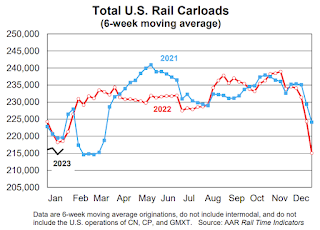 Click on graph for larger image.
Click on graph for larger image.This graph from the Rail Time Indicators report shows the six-week average of U.S. Carloads in 2021, 2022 and 2022:
The good news is total U.S. carloads were up 2.2%, or 19,827 carloads, in January 2023 over January 2022. The bad news is January 2022 was the worst January for total carloads in our records that go back to 1988, so a 2.2% increase — while certainly better than some alternatives — is less impressive than it could be.
 The second graph shows the six-week average (not monthly) of U.S. intermodal in 2021, 2022 and 2023: (using intermodal or shipping containers):
The second graph shows the six-week average (not monthly) of U.S. intermodal in 2021, 2022 and 2023: (using intermodal or shipping containers):U.S. railroads also originated 919,928 intermodal containers and trailers in January 2023, down 8.1%, or 81,443 units, from January 2022. Intermodal volume averaged 229,982 units per week in January 2023, the fewest for January since 2013. January 2023 was the first time since March 2017 that the number of originated carloads exceeded the number of originated intermodal units on U.S. railroads.
Lawler: Net Home Orders and Sales Cancellations of Large Publicly-Traded Home Builders
by Calculated Risk on 2/03/2023 01:04:00 PM
Today, in the Calculated Risk Real Estate Newsletter: Lawler: Net Home Orders and Sales Cancellations of Large Publicly-Traded Home Builders
A brief excerpt:
Note from Bill McBride: The data below via Tom Lawler illustrates the point I’ve made about the Census Bureau overstating sales when cancellation rates are rising.There is much more in the article. You can subscribe at https://calculatedrisk.substack.com/
...
From housing economist Tom Lawler:
Below is a table of net home orders (gross orders less sales cancellations) of selected publicly-traded home builders for last quarter compared to the comparable quarter of 2021. (Note: sales cancellations from some builders are derived from reported cancellation rates, and may be off due to rounding). Also shown are gross orders, as well as unadjusted new home sales reported by Census.
As the table shows, net orders of these builders last quarter were down 41.3% YOY, sales cancellations were up 58.7%, and gross orders were down 27.5%. Census preliminary estimates of new home sales last quarter, in contrast, were down 19.3% YOY.
Comments on January Employment Report
by Calculated Risk on 2/03/2023 09:44:00 AM
This was a strong report, and the revisions show job growth was stronger over the last year than originally reported. With revisions: The 4.81 million jobs added, 2022 was the 2nd best year for job growth in US history behind only 2021 with 7.27 million.
The headline jobs number in the January employment report was well above expectations, and employment for the previous two months was revised up by 71,000, combined. The participation rate increased, and the unemployment rate decreased to 3.4% - the lowest rate since May 1969 (over 50 years ago!)
In January, the year-over-year employment change was 4.97 million jobs.
Prime (25 to 54 Years Old) Participation
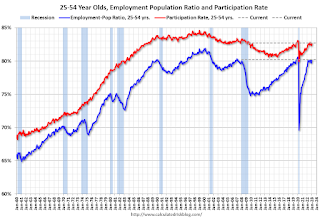 Since the overall participation rate is impacted by both cyclical (recession) and demographic (aging population, younger people staying in school) reasons, here is the employment-population ratio for the key working age group: 25 to 54 years old.
Since the overall participation rate is impacted by both cyclical (recession) and demographic (aging population, younger people staying in school) reasons, here is the employment-population ratio for the key working age group: 25 to 54 years old.The 25 to 54 participation rate increased in January to 82.7% from 82.4% in December, and the 25 to 54 employment population ratio increased to 80.2% from 80.1% the previous month.
Average Hourly Wages
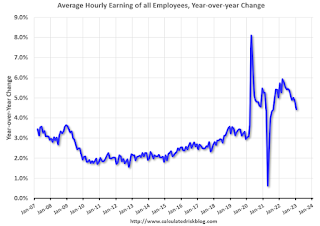 The graph shows the nominal year-over-year change in "Average Hourly Earnings" for all private employees from the Current Employment Statistics (CES).
The graph shows the nominal year-over-year change in "Average Hourly Earnings" for all private employees from the Current Employment Statistics (CES). Wage growth has trended down after peaking at 5.9% YoY in March 2022 and was at 4.4% YoY in January, down from 4.6% in December.
Part Time for Economic Reasons
 From the BLS report:
From the BLS report:"The number of persons employed part time for economic reasons, at 4.1 million, was little changed in January. These individuals, who would have preferred full-time employment, were working part time because their hours had been reduced or they were unable to find full-time jobs."The number of persons working part time for economic reasons increased in January to 4.050 million from 3.878 million in December. This is at pre-recession levels.
These workers are included in the alternate measure of labor underutilization (U-6) that increased to 6.6% from 6.5% in the previous month. This is down from the record high in April 22.9% and last month was the lowest level on record (seasonally adjusted) (series started in 1994). This measure is below the level in February 2020 (pre-pandemic).
Unemployed over 26 Weeks
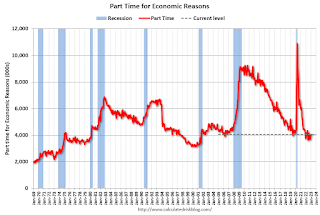 This graph shows the number of workers unemployed for 27 weeks or more.
This graph shows the number of workers unemployed for 27 weeks or more. According to the BLS, there are 1.111 million workers who have been unemployed for more than 26 weeks and still want a job, up from 1.069 million the previous month.
This is at pre-pandemic levels.
Summary:
The headline monthly jobs number was well above expectations and employment for the previous two months was revised up by 71,000, combined. The annual benchmark revision indicated job growth was significantly stronger than originally reported.
January Employment Report: 517 thousand Jobs, 3.4% Unemployment Rate
by Calculated Risk on 2/03/2023 08:49:00 AM
From the BLS:
Total nonfarm payroll employment rose by 517,000 in January, and the unemployment rate changed little at 3.4 percent, the U.S. Bureau of Labor Statistics reported today. Job growth was widespread, led by gains in leisure and hospitality, professional and business services, and health care. Employment also increased in government, partially reflecting the return of workers from a strike.
...
The change in total nonfarm payroll employment for November was revised up by 34,000, from +256,000 to +290,000, and the change for December was revised up by 37,000, from +223,000 to +260,000. With these revisions, employment gains in November and December combined were 71,000 higher than previously reported.
emphasis added
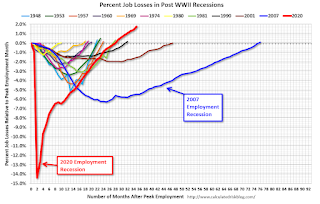 Click on graph for larger image.
Click on graph for larger image.The first graph shows the job losses from the start of the employment recession, in percentage terms.
The current employment recession was by far the worst recession since WWII in percentage terms.
 The second graph shows the year-over-year change in total non-farm employment since 1968.
The second graph shows the year-over-year change in total non-farm employment since 1968.In January, the year-over-year change was 4.97 million jobs. Employment was up significantly year-over-year.
Total payrolls increased by 517 thousand in January. Private payrolls increased by 443 thousand, and public payrolls increased 74 thousand.
Payrolls for November and December were revised up 71 thousand, combined.
The third graph shows the employment population ratio and the participation rate.
 The Labor Force Participation Rate increased to 62.4% in January, from 62.3% in December. This is the percentage of the working age population in the labor force.
The Labor Force Participation Rate increased to 62.4% in January, from 62.3% in December. This is the percentage of the working age population in the labor force. The Employment-Population ratio increased to 60.2% from 60.1% (blue line).
I'll post the 25 to 54 age group employment-population ratio graph later.
 The fourth graph shows the unemployment rate.
The fourth graph shows the unemployment rate. The unemployment rate decreased in January to 3.4% from 3.5% in December.
This was well above consensus expectations; and November and December payrolls were revised up by 71,000 combined.
The total nonfarm employment level for March 2022 was revised upward by 568,000 (+506,000 on a not seasonally adjusted basis, or +0.3 percent). The average not seasonally adjusted benchmark revision (in absolute terms) over the past 10 years is 0.1 percent.
Thursday, February 02, 2023
Friday: Employment Report
by Calculated Risk on 2/02/2023 08:56:00 PM

Friday:
• At 8:30 AM ET, Employment Report for December. The consensus is for 185,000 jobs added, and for the unemployment rate to increase to 3.6%.
• At 10:00 AM, ISM Services Index for January.
January Employment Preview
by Calculated Risk on 2/02/2023 12:41:00 PM
On Friday at 8:30 AM ET, the BLS will release the employment report for January. The consensus is for 185,000 jobs added, and for the unemployment rate to increase to 3.6%.
From BofA economists:
"Nonfarm payrolls likely rose by 225k in January, little changed from the December increase. Payrolls were likely boosted by the end of the strike by University of California workers in late December. The strike affected 36k workers according to the BLS and likely largely explained the ~24k drop in state education employment in December. These workers should return to payrolls in January."From Goldman Sachs:
"We continue to expect a strong employment report, and we left our nonfarm payroll forecast unchanged at +300k (mom sa)."
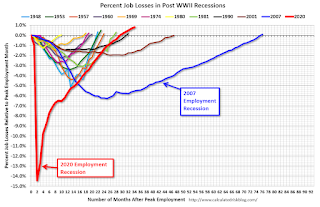 Click on graph for larger image.
Click on graph for larger image.• First, as of December there were 1.24 million more jobs than in February 2020 (the month before the pandemic).
This graph shows the job losses from the start of the employment recession, in percentage terms. As of August 2022, the total number of jobs had returned.
• Annual Benchmark Revision: The benchmark revision for 2021 will be released with the January employment report. The above graph doesn't include the preliminary benchmark revision that showed there were 462 thousand more jobs than originally reported in March 2022.
• ADP Report: The ADP employment report showed 106,000 private sector jobs were added in January. This suggests job gains below consensus expectations. ADP chief economist Nela Richardson noted: "In January, we saw the impact of weather-related disruptions on employment during our reference week. Hiring was stronger during other weeks of the month, in line with the strength we saw late last year."
• ISM Surveys: Note that the ISM indexes are diffusion indexes based on the number of firms hiring (not the number of hires). The ISM® manufacturing employment index decreased in January to 50.6%, down from 50.8% last month. This would suggest the number of manufacturing jobs was mostly unchanged in January.
The ISM® services employment index for January has not been released yet.
• Unemployment Claims: The weekly claims report showed a decrease in the number of initial unemployment claims during the reference week (includes the 12th of the month) from 216,000 in December to 192,000 in January. This would usually suggest fewer layoffs in January than in December. In general, weekly claims were below expectations in January.
Inflation Adjusted House Prices 3.6% Below Peak
by Calculated Risk on 2/02/2023 09:45:00 AM
Today, in the Calculated Risk Real Estate Newsletter: Inflation Adjusted House Prices 3.8% Below Peak; Price-to-rent index is 6.1% below recent peak
Excerpt:
It has been 17 years since the bubble peak. In the November Case-Shiller house price index released on Tuesday, the seasonally adjusted National Index (SA), was reported as being 61% above the bubble peak in 2006. However, in real terms, the National index (SA) is about 12% above the bubble peak (and historically there has been an upward slope to real house prices). The composite 20, in real terms, is about 2% above the bubble peak.
Both indexes have declined for six consecutive months in real terms (inflation adjusted).
People usually graph nominal house prices, but it is also important to look at prices in real terms. As an example, if a house price was $200,000 in January 2000, the price would be almost $339,000 today adjusted for inflation (69.5% increase). That is why the second graph below is important - this shows "real" prices. ...
In October 2004, Fed economist John Krainer and researcher Chishen Wei wrote a Fed letter on price to rent ratios: House Prices and Fundamental Value. Kainer and Wei presented a price-to-rent ratio using the OFHEO house price index and the Owners' Equivalent Rent (OER) from the BLS.
Note that OER is lagging behind other measures of rent.
Here is a similar graph using the Case-Shiller National and Composite 20 House Price Indexes. This graph shows the price to rent ratio (January 2000 = 1.0). The price-to-rent ratio had been moving more sideways but picked up significantly following the onset of the pandemic.
On a price-to-rent basis, the Case-Shiller National and Composite 20 indexes declined again in November for the sixth consecutive month. The price-to-rent index for the National index is off 6.1% from the recent peak, and the Composite 20 based index is off 7.7%.
Weekly Initial Unemployment Claims decrease to 183,000
by Calculated Risk on 2/02/2023 08:33:00 AM
The DOL reported:
In the week ending January 28, the advance figure for seasonally adjusted initial claims was 183,000, a decrease of 3,000 from the previous week's unrevised level of 186,000. The 4-week moving average was 191,750, a decrease of 5,750 from the previous week's unrevised average of 197,500.The following graph shows the 4-week moving average of weekly claims since 1971.
emphasis added
 Click on graph for larger image.
Click on graph for larger image.The dashed line on the graph is the current 4-week average. The four-week average of weekly unemployment claims decreased to 191,750.
The previous week was unrevised.
Weekly claims were below the consensus forecast.
Wednesday, February 01, 2023
Vehicles Sales Increased to 15.74 million SAAR in January
by Calculated Risk on 2/01/2023 09:41:00 PM
Wards Auto released their estimate of light vehicle sales for January: U.S. Light-Vehicle Sales Record Fifth Consecutive Increase in January (pay site).
Wards Auto estimates sales of 15.74 million SAAR in January 2023 (Seasonally Adjusted Annual Rate), up 17.6% from the December sales rate, and up 4.2% from January 2022.
 Click on graph for larger image.
Click on graph for larger image.This graph shows light vehicle sales since 2006 from the BEA (blue) and Wards Auto's estimate for January (red).
The impact of COVID-19 was significant, and April 2020 was the worst month. After April 2020, sales increased, and were close to sales in 2019 (the year before the pandemic). However, sales decreased late last year due to supply issues. It appears the "supply chain bottom" was in September 2021.
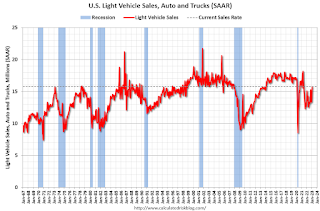 The second graph shows light vehicle sales since the BEA started keeping data in 1967.
The second graph shows light vehicle sales since the BEA started keeping data in 1967. BLS: Job Openings Increased to 11.0 million in December
by Calculated Risk on 2/01/2023 04:00:00 PM
From the BLS: Job Openings and Labor Turnover Summary
The number of job openings increased to 11.0 million on the last business day of December, the U.S. Bureau of Labor Statistics reported today. Over the month, the number of hires and total separations changed little at 6.2 million and 5.9 million, respectively. Within separations, quits (4.1 million) and layoffs and discharges (1.5 million) changed little.The following graph shows job openings (black line), hires (dark blue), Layoff, Discharges and other (red column), and Quits (light blue column) from the JOLTS.
emphasis added
This series started in December 2000.
Note: The difference between JOLTS hires and separations is similar to the CES (payroll survey) net jobs headline numbers. This report is for December the employment report this Friday will be for January.
 Click on graph for larger image.
Click on graph for larger image.Note that hires (dark blue) and total separations (red and light blue columns stacked) are usually pretty close each month. This is a measure of labor market turnover. When the blue line is above the two stacked columns, the economy is adding net jobs - when it is below the columns, the economy is losing jobs.
The spike in layoffs and discharges in March 2020 is labeled, but off the chart to better show the usual data.
Jobs openings increased in December to 11.012 million from 10.440 million in November.
The number of job openings (black) were down 4% year-over-year.
Quits were down 7% year-over-year. These are voluntary separations. (See light blue columns at bottom of graph for trend for "quits").
FOMC Statement: Raise Rates 25 bp; "Ongoing increases appropriate"
by Calculated Risk on 2/01/2023 02:01:00 PM
Fed Chair Powell press conference video here or on YouTube here, starting at 2:30 PM ET.
FOMC Statement:
Recent indicators point to modest growth in spending and production. Job gains have been robust in recent months, and the unemployment rate has remained low. Inflation has eased somewhat but remains elevated.
Russia's war against Ukraine is causing tremendous human and economic hardship and is contributing to elevated global uncertainty. The Committee is highly attentive to inflation risks.
The Committee seeks to achieve maximum employment and inflation at the rate of 2 percent over the longer run. In support of these goals, the Committee decided to raise the target range for the federal funds rate to 4-1/2 to 4-3/4 percent. The Committee anticipates that ongoing increases in the target range will be appropriate in order to attain a stance of monetary policy that is sufficiently restrictive to return inflation to 2 percent over time. In determining the extent of future increases in the target range, the Committee will take into account the cumulative tightening of monetary policy, the lags with which monetary policy affects economic activity and inflation, and economic and financial developments. In addition, the Committee will continue reducing its holdings of Treasury securities and agency debt and agency mortgage-backed securities, as described in its previously announced plans. The Committee is strongly committed to returning inflation to its 2 percent objective.
In assessing the appropriate stance of monetary policy, the Committee will continue to monitor the implications of incoming information for the economic outlook. The Committee would be prepared to adjust the stance of monetary policy as appropriate if risks emerge that could impede the attainment of the Committee's goals. The Committee's assessments will take into account a wide range of information, including readings on labor market conditions, inflation pressures and inflation expectations, and financial and international developments.
Voting for the monetary policy action were Jerome H. Powell, Chair; John C. Williams, Vice Chair; Michael S. Barr; Michelle W. Bowman; Lael Brainard; Lisa D. Cook; Austan D. Goolsbee; Patrick Harker; Philip N. Jefferson; Neel Kashkari; Lorie K. Logan; and Christopher J. Waller.
emphasis added
Rents Continue to Decline; "Apartment Market Loosens"
by Calculated Risk on 2/01/2023 11:39:00 AM
Today, in the Calculated Risk Real Estate Newsletter: Rents Continue to Decline; "Apartment Market Loosens"
A brief excerpt:
The rental market has changed rapidly. This index from the National Multifamily Housing Council (NMHC) has been an excellent leading indicator for rents and vacancy rates, and this suggests higher vacancy rates and falling asking rents in the coming months.There is much more in the article. You can subscribe at https://calculatedrisk.substack.com/
From the NMHC: Rents Continue to Fall as Apartment Market Loosens, Transactions Pull Back Due to Higher Interest Rates
• The Market Tightness Index came in at 14 this quarter—well below the breakeven level (50)—indicating looser market conditions for the second consecutive quarter. Over three-quarters of respondents (78%) reported markets to be looser than three months ago, while only 5% thought markets have become tighter. Another 16% of respondents thought that market conditions were unchanged over the past three months.
Construction Spending Decreased 0.4% in December
by Calculated Risk on 2/01/2023 10:22:00 AM
From the Census Bureau reported that overall construction spending decreased:
Construction spending during December 2022 was estimated at a seasonally adjusted annual rate of $1,809.8 billion, 0.4 percent below the revised November estimate of $1,817.3 billion. The December figure is 7.7 percent above the December 2021 estimate of $1,681.0 billion.Both private and public spending decreased:
The value of construction in 2022 was $1,792.9 billion, 10.2 percent above the $1,626.4 billion spent in 2021.
emphasis added
Spending on private construction was at a seasonally adjusted annual rate of $1,427.1 billion, 0.4 percent below the revised November estimate of $1,432.9 billion. ...
In December, the estimated seasonally adjusted annual rate of public construction spending was $382.7 billion, 0.4 percent below the revised November estimate of $384.4 billion.
 Click on graph for larger image.
Click on graph for larger image.This graph shows private residential and nonresidential construction spending, and public spending, since 1993. Note: nominal dollars, not inflation adjusted.
Residential (red) spending is 9.3% below the recent peak.
Non-residential (blue) spending is slightly below the peak last month.
Public construction spending is close to the recent peak.
 The second graph shows the year-over-year change in construction spending.
The second graph shows the year-over-year change in construction spending.On a year-over-year basis, private residential construction spending is up 1.7%. Non-residential spending is up 15.0% year-over-year. Public spending is up 11.7% year-over-year.
ISM® Manufacturing index Declined to 47.4% in January
by Calculated Risk on 2/01/2023 10:05:00 AM
(Posted with permission). The ISM manufacturing index indicated contraction. The PMI® was at 47.4% in January, down from 48.4% in December. The employment index was at 50.6%, down from 50.8% last month, and the new orders index was at 42.5%, down from 45.1%.
From ISM: Manufacturing PMI® at 47.4%
January 2023 Manufacturing ISM® Report On Business®
conomic activity in the manufacturing sector contracted in January for the third consecutive month following a 28-month period of growth, say the nation's supply executives in the latest Manufacturing ISM® Report On Business®.This suggests manufacturing contracted in January. This was below the consensus forecast. Note that prices are falling.
The report was issued today by Timothy R. Fiore, CPSM, C.P.M., Chair of the Institute for Supply Management® (ISM®) Manufacturing Business Survey Committee:
“The January Manufacturing PMI® registered 47.4 percent, 1 percentage point lower than the seasonally adjusted 48.4 percent recorded in December. Regarding the overall economy, this figure indicates a second month of contraction after a 30-month period of expansion. The Manufacturing PMI® figure is the lowest since May 2020, when it registered a seasonally adjusted 43.5 percent. The New Orders Index remained in contraction territory at 42.5 percent, 2.6 percentage points lower than the seasonally adjusted figure of 45.1 percent recorded in December. The Production Index reading of 48 percent is a 0.6-percentage point decrease compared to December’s seasonally adjusted figure of 48.6 percent. The Prices Index registered 44.5 percent, up 5.1 percentage points compared to the December figure of 39.4 percent. The Backlog of Orders Index registered 43.4 percent, 2 percentage points higher than the December reading of 41.4 percent. The Employment Index continued in expansion territory (50.6 percent, down 0.2 percentage point from December’s seasonally adjusted 50.8 percent) after emerging from contraction territory (48.9 percent, seasonally adjusted) in November. The Supplier Deliveries Index figure of 45.6 percent is 0.5 percentage point higher than the 45.1 percent recorded in December; the last two readings are the index’s lowest since March 2009 (43.2 percent). The Inventories Index registered 50.2 percent, 2.1 percentage points lower than the seasonally adjusted December reading of 52.3 percent. The New Export Orders Index reading of 49.4 percent is 3.2 percentage points higher than December’s figure of 46.2 percent. The Imports Index continued in contraction territory at 47.8 percent, 2.7 percentage points above the December reading of 45.1 percent.”
emphasis added


